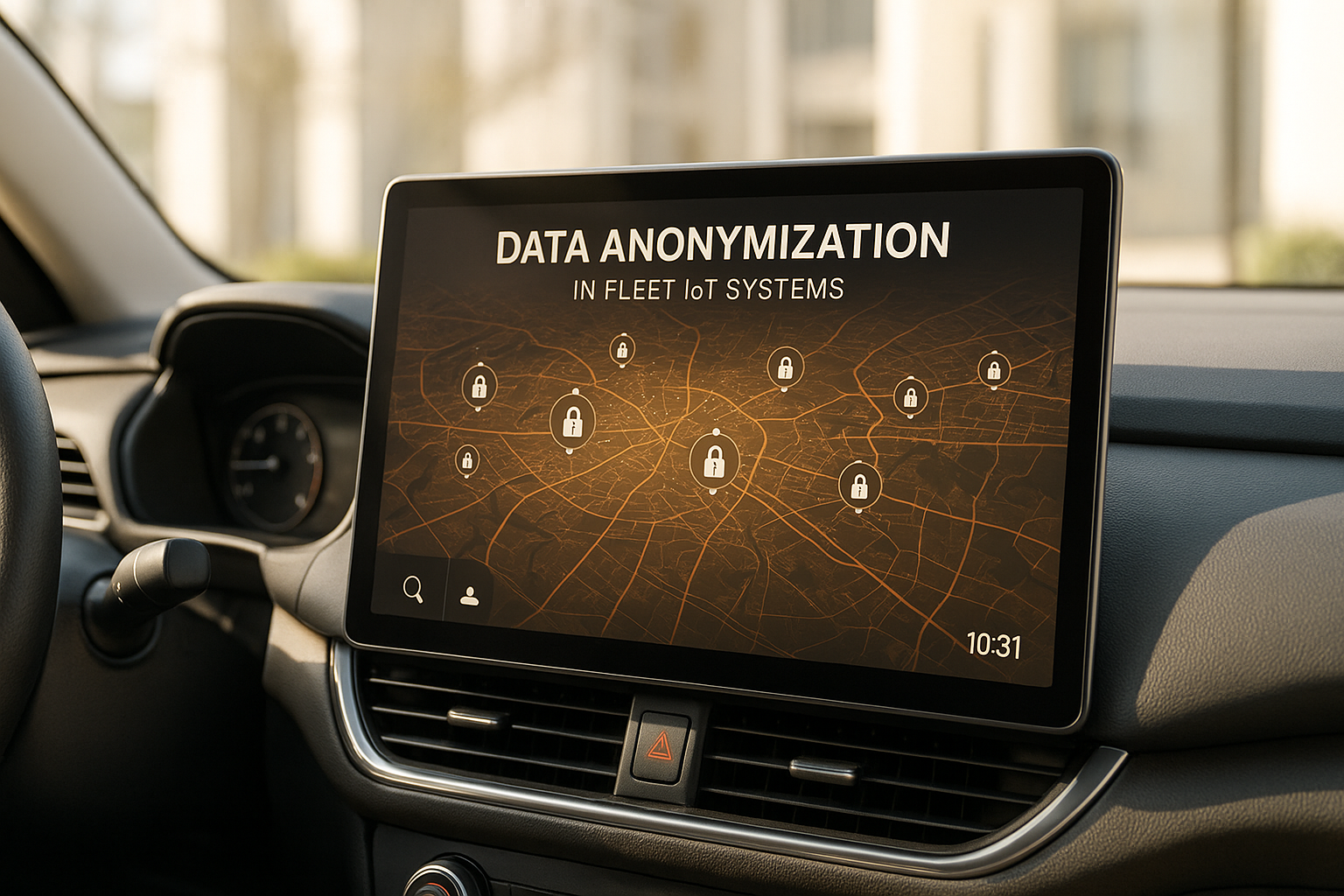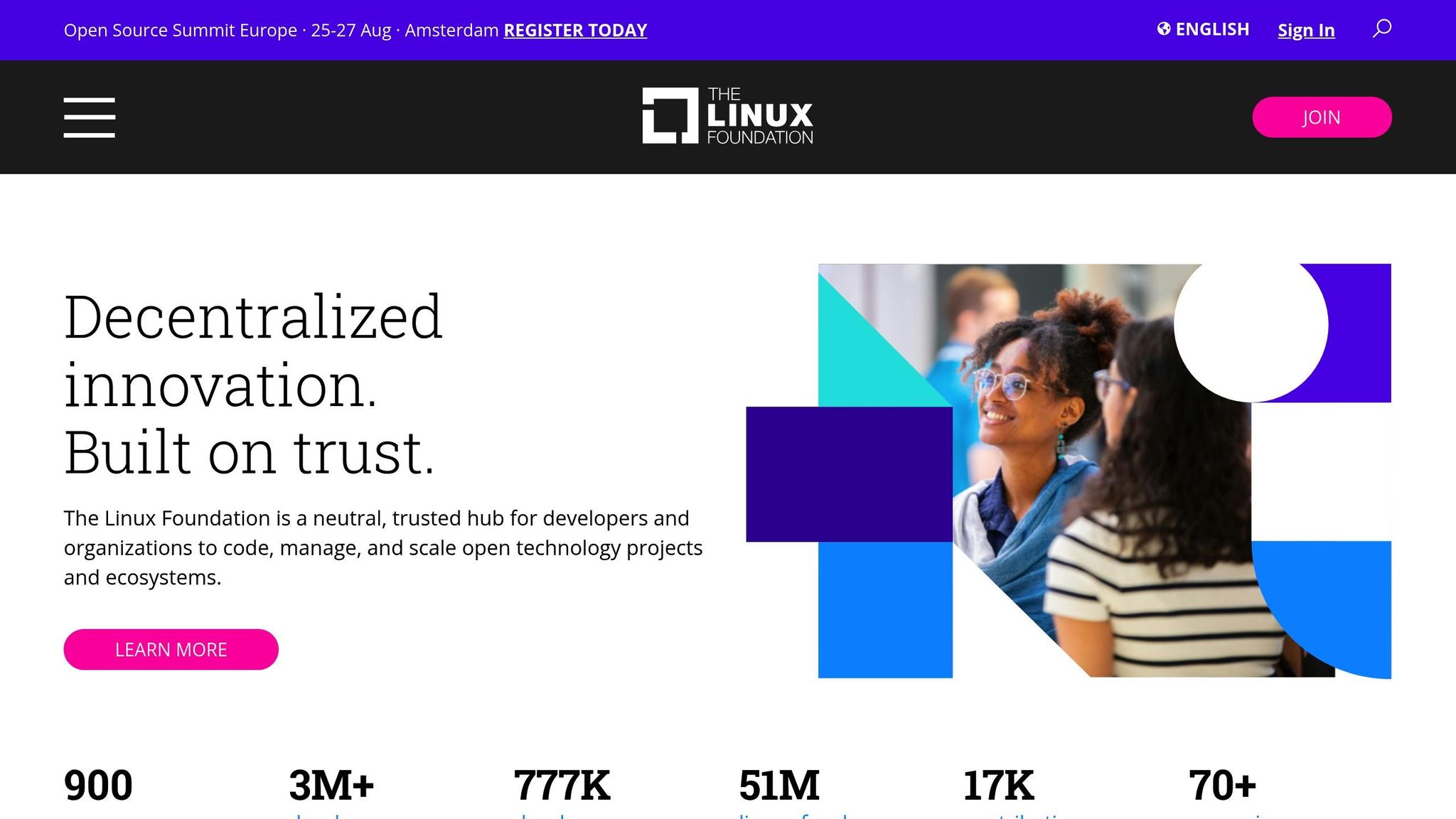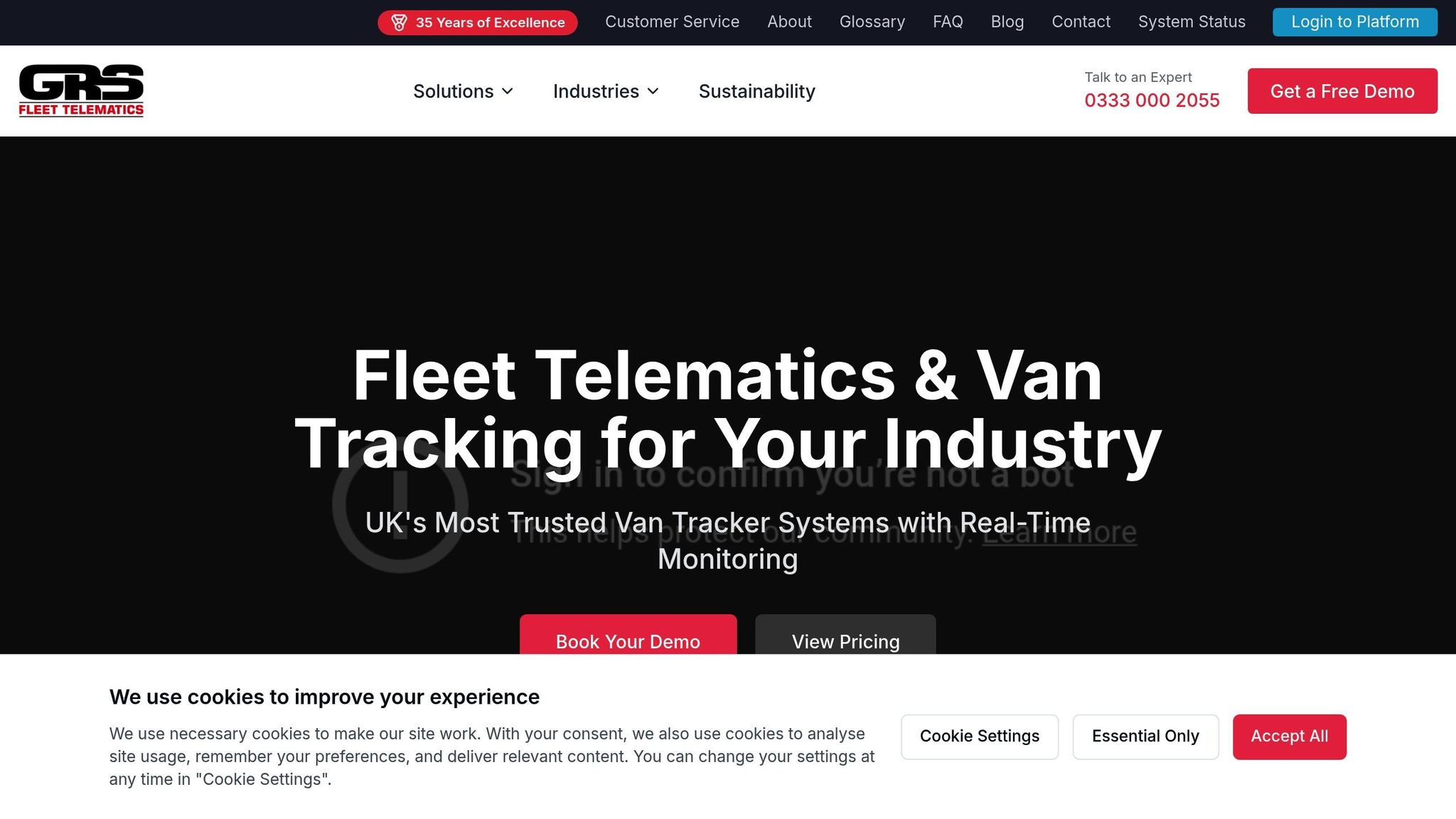Data Anonymization in Fleet IoT Systems
Michael Bar

Fleet IoT systems generate vast amounts of sensitive data every day, from vehicle locations to driver behaviour patterns. While this data is useful for improving fleet operations, it poses privacy risks if mishandled. For UK fleet operators, data anonymisation is a key solution to ensure compliance with GDPR and the Data Protection Act 2018 while maintaining trust with employees and partners. Here's what you need to know:
- What is Data Anonymisation? It involves removing or altering personal identifiers (e.g., GPS data, driver names) to prevent re-identification while keeping the data useful for analytics.
- Why It’s Important: UK laws classify much of this data as personal, requiring explicit consent for processing. Non-compliance can lead to fines of up to £17.5 million or 4% of global turnover.
- Techniques Used: Methods include data masking, pseudonymisation, tokenisation, aggregation, noise addition, k-anonymity, and differential privacy. These balance privacy with data utility.
- Challenges: High data volume, real-time processing needs, and legacy system integration make anonymisation complex but achievable with strategies like edge computing and privacy-by-design.
- Best Practices: Use layered anonymisation, adopt strict data retention policies, and regularly audit security measures. Training staff and managing third-party vendors are also crucial.
Main Data Anonymisation Techniques in Fleet IoT Systems
Overview of Anonymisation Methods
Fleet IoT systems demand specific anonymisation strategies that balance the need for privacy with the usefulness of the data. Here's a look at the main techniques and how they apply to fleet IoT systems.
Data masking involves substituting sensitive details with artificial values. For example, in fleet systems, actual vehicle registration numbers might be replaced with randomly generated ones that mimic the original format. A van with the registration "AB12 CDE" could become "XY99 FGH" in the anonymised dataset. The structure remains intact, enabling analytics tools to function without exposing the true identity of the vehicle.
Pseudonymisation replaces personal data with consistent but unrelated identifiers, maintaining relationships within the dataset. For instance, a driver might be identified as "Driver_7842" across various systems. This allows for long-term analysis of driving behaviours without revealing the driver's actual identity, making it ideal for monitoring performance or training progress over time.
Tokenisation substitutes sensitive data with tokens that have no intrinsic meaning. Fleet operators often use this for vehicle identification numbers or driver IDs. The original data is securely stored in a separate token vault, while operational systems work with the tokens. This ensures that even if the operational database is breached, the original data cannot be reconstructed from the tokens.
Aggregation and generalisation involve grouping data points into broader categories or summarising them. For example, instead of recording precise GPS coordinates, a fleet system might note general areas like "Central London." Similarly, exact timestamps could be replaced with broader time ranges, such as "between 2 PM and 3 PM." These methods work well for tasks like route optimisation or traffic analysis, where precise details are unnecessary.
Noise addition introduces small random variations to numerical data. For instance, a vehicle's fuel consumption recorded as 8.5 litres per 100 km might be adjusted to 8.3 or 8.7 litres. While individual data points lose precision, overall trends and averages remain accurate, making this technique suitable for fleet-wide analysis.
K-anonymity ensures that each record in a dataset is indistinguishable from at least k-1 others. In fleet contexts, this might mean ensuring that combinations of attributes like route, time, and vehicle type appear in at least five records. This makes it difficult to isolate specific vehicles or drivers in the dataset.
Differential privacy adds controlled noise to query results rather than altering the raw data. For example, when a fleet manager requests average speeds for a route, the system introduces slight random variations to the result. This protects individual data while still providing actionable insights for decision-making.
Comparison of Techniques
Each anonymisation method comes with its own balance of privacy, utility, and complexity. Understanding these trade-offs helps fleet operators select the right approach for their needs.
| Technique | Privacy Level | Data Utility | Implementation Complexity | Best Use Case |
|---|---|---|---|---|
| Data Masking | Medium | High | Low | Vehicle identifiers, driver names |
| Pseudonymisation | Medium-High | High | Medium | Performance tracking, behaviour analysis |
| Tokenisation | High | High | High | Sensitive IDs, payment information |
| Aggregation | High | Medium | Low | Route planning, traffic analysis |
| Noise Addition | Medium | Medium-High | Medium | Fuel consumption, speed data |
| K-anonymity | High | Medium | High | Research datasets, third-party sharing |
| Differential Privacy | Very High | Medium | Very High | Statistical reporting, benchmarking |
Privacy level measures how well the method protects against re-identification. Differential privacy offers the strongest protection, while data masking provides a basic layer of security that may be vulnerable to certain attacks.
Data utility reflects how useful the anonymised data remains for operational purposes. Techniques like pseudonymisation and tokenisation retain high utility by preserving data relationships and formats. Aggregation, while secure, reduces granularity, limiting its usefulness in some scenarios.
Implementation complexity varies widely. Basic techniques like data masking are easy to implement with standard database tools, but advanced methods like differential privacy require mathematical expertise and specialised software.
The choice of technique often depends on how the data will be used. For internal analytics, pseudonymisation or tokenisation works well because they protect identities while preserving data relationships. For third-party sharing, stronger techniques like k-anonymity or differential privacy are often necessary to meet regulatory standards and guard against re-identification.
Fleet operators frequently combine methods for more comprehensive protection. For example, they might use noise addition for location data and pseudonymisation for driver metrics.
Regulations also play a key role. The GDPR recognises pseudonymisation as an effective safeguard, making it a popular choice among UK fleet operators. However, compliance often requires additional technical and organisational measures beyond pseudonymisation alone.
Data Anonymization for Telco AI Use Cases - Sridhar Rao, The Linux Foundation

Implementation Challenges and Best Practices
While the earlier sections explained anonymisation techniques, putting these methods into practice comes with its own set of hurdles. Tackling these challenges requires well-thought-out strategies that balance privacy and functionality.
Challenges in Anonymising Fleet IoT Data
Fleet IoT systems churn out massive amounts of data daily, sourced from a variety of sensors. This includes GPS tracking, engine diagnostics, fuel usage, and driver behaviour. Handling this sheer volume of data while applying anonymisation algorithms can strain computational resources and requires meticulous system design to maintain performance.
Real-time data processing adds another layer of complexity. Fleet management systems often rely on instant access to critical information, such as vehicle incidents or unexpected route changes. Any delay caused by anonymisation processes could compromise the timeliness of emergency alerts or decision-making.
Another hurdle is the integration of data from diverse devices and older systems. Fleet IoT setups often include equipment from multiple manufacturers, each using unique formats and communication protocols. Anonymising data across these varied systems while preserving the relationships between datasets demands precise mapping and standardisation.
Moreover, anonymisation can sometimes reduce the value of the data by breaking critical connections. For example, calculating fuel efficiency requires linking driver behaviour with vehicle and journey data. If anonymisation disrupts these links, it can limit the data's usefulness for operational insights.
Finally, regulatory compliance, particularly under GDPR, poses its own challenges. Many legacy systems were not built with privacy in mind, making it difficult to retrofit them with anonymisation features. This often requires extensive modifications or middleware solutions to meet compliance standards.
Best Practices for Effective Anonymisation
Addressing these challenges calls for a strategic approach that ensures both privacy and data utility.
One effective strategy is to adopt a privacy-by-design approach. By separating personally identifiable information (PII) from operational data at the point of collection, organisations can securely store sensitive details while using pseudonymised identifiers for routine operations. This reduces privacy risks and simplifies regulatory compliance.
Using edge computing can also help. Processing data locally - either in vehicles or at depots - before sending it to central systems reduces latency, minimises bandwidth use, and limits the exposure of raw data. Combining techniques like pseudonymisation for sensitive data, adding noise to location details, and aggregating route data can enhance both security and usability.
Implementing strict data retention policies is another key step. While aggregated insights from historical data can be valuable, holding onto detailed raw data for too long increases privacy risks unnecessarily.
Regular security audits are essential to keep anonymisation methods up to date. Periodic reviews of algorithms, access controls, and key management practices help organisations stay ahead of emerging threats.
Adopting a Zero Trust security model further strengthens protection. By verifying all network traffic - whether internal or external - organisations can minimise the impact of breaches and maintain detailed audit trails.
Automated compliance monitoring systems can also play a crucial role. These systems track adherence to anonymisation policies, flag potential violations, monitor access patterns, and generate reports required for regulatory purposes.
| Challenge | Solution | Priority | Outcome |
|---|---|---|---|
| High data volume | Edge computing | High | Reduced latency and bandwidth use |
| Real-time processing | Layered anonymisation techniques | High | Maintained responsiveness |
| Device diversity | Standardised data formats | Medium | Easier integration |
| Regulatory compliance | Automated monitoring | High | Consistent adherence to regulations |
| Legacy systems | Privacy-by-design architecture | Medium | Simplified integration |
Equipping staff with the right knowledge is equally important. Regular training sessions on privacy regulations, data handling protocols, and incident response procedures ensure employees are prepared to act as the first line of defence against breaches.
Vendor management is another critical area. Organisations should extend anonymisation requirements to third-party providers through contracts, audits, and oversight of data-sharing agreements to mitigate risks across the supply chain.
Lastly, having a solid incident response plan is non-negotiable. Preparing detailed procedures for containing breaches, assessing their impact, notifying authorities, and restoring operations ensures a swift and coordinated response when things go wrong.
Legal and Ethical Requirements for UK Fleet Operators
In the UK, fleet operators must navigate a landscape shaped by legal mandates and ethical considerations, especially when it comes to managing IoT systems. These obligations ensure the secure and trustworthy operation of fleet technologies.
Ethical Responsibilities in Data Collection and Usage
When it comes to handling personal data, fleet operators have a clear ethical duty: only gather the information that’s genuinely necessary for operational purposes. Beyond that, they must be upfront about their data practices, ensuring transparency to earn and maintain trust. By doing so, they not only meet ethical expectations but also foster stronger relationships with stakeholders.
Regulatory Compliance in the UK
On the legal side, fleet operators are bound by the General Data Protection Regulation (GDPR) and the Data Protection Act 2018. These laws outline stringent rules on how IoT data should be collected, processed, and stored. To comply, operators need to implement robust security measures, safeguarding the data against breaches and misuse. Failure to do so can lead to serious legal consequences, making strict adherence a non-negotiable priority.
Data Anonymisation in Practice: The GRS Fleet Telematics Approach

Ensuring data privacy in fleet tracking is no small feat, but GRS Fleet Telematics shows how it can be done effectively. By combining operational efficiency with strong security protocols, the company offers a solution that prioritises privacy for UK businesses. Their approach is a practical extension of the technical and regulatory frameworks discussed earlier.
At the heart of their system lies an advanced security framework designed to protect sensitive data while maintaining high-performance tracking capabilities. GRS Fleet Telematics has seamlessly integrated these principles into their solutions, ensuring that businesses can rely on their systems without compromising on data protection.
One standout feature is the Double-Tracker System. This setup pairs a wired GPS tracker with a hidden Bluetooth backup device, creating redundant data streams. The result? Enhanced vehicle recovery rates, all while keeping driver and route information secure from unauthorised access.
Tailored Hardware and Software Solutions
GRS Fleet Telematics offers a range of hardware packages to suit different needs:
- Essential (£35): Core tracking features with built-in privacy safeguards.
- Enhanced (£79): Adds a secondary Bluetooth backup for added theft prevention.
- Ultimate (£99): Includes immobilisation capabilities alongside advanced security features.
Complementing the hardware is a software subscription model priced at £7.99 per vehicle each month. This service grants access to the tracking platform and includes secure data handling, SIM connectivity, and dedicated account management. Together, these elements ensure that privacy and security remain central to the service.
Benefits for UK Fleet Operators
The security measures implemented by GRS Fleet Telematics offer tangible advantages for fleet operators. Their dual-tracker technology boasts a 91% recovery rate, providing precise location data and 24/7 recovery support while safeguarding historical tracking records.
Driver privacy is another key focus. The system tracks vehicle performance, route efficiency, and safety metrics without exposing personal driver details. This allows fleet managers to maintain oversight while respecting privacy laws and meeting regulatory requirements.
Beyond tracking, the system aids in fleet optimisation. Features like route planning and fuel efficiency monitoring help reduce costs and improve overall performance - all without compromising sensitive data.
Scalability is another strength. Whether managing a small fleet of five vehicles or a larger one with fifty, the solution maintains its high standards of privacy and security while ensuring compliance with UK regulations.
Additionally, white-label branding options allow businesses to retain their corporate identity. This ensures that secure data handling aligns with brand consistency and strengthens customer trust. Every aspect of GRS Fleet Telematics’ solution is designed to create a secure, efficient, and privacy-conscious fleet management ecosystem.
Conclusion
Data anonymisation has become a critical consideration for UK businesses managing fleet IoT systems in an era where privacy concerns are front and centre. With 71% of people expressing worries about how their data is handled and protected, fleet operators face the dual challenge of maintaining operational efficiency while ensuring robust privacy measures.
To achieve this, anonymisation requires careful evaluation of data sensitivity and the selection of appropriate techniques that align with UK regulations. This balance ensures that data remains useful for analysis while safeguarding personal information. Techniques like data masking, pseudonymisation, differential privacy, and k-anonymity each offer specific benefits, but their success hinges on matching the method to the data’s sensitivity and intended application.
Compliance with regulations, particularly GDPR, is non-negotiable. UK fleet operators must not only meet legal requirements but also fulfil their ethical obligations to drivers and customers. This involves embedding privacy by design, practising data minimisation, and maintaining strong security measures throughout the data lifecycle. These steps are essential for building trust and adhering to legal standards.
A practical example of these principles in action is GRS Fleet Telematics. Their dual-tracker system boasts a 91% recovery rate while adhering to strict data protection protocols. By combining advanced tracking hardware with affordable software subscriptions, GRS Fleet Telematics exemplifies compliance with UK regulations and ethical data practices.
As AI-driven cyber threats continue to evolve, it’s vital for organisations to regularly update their anonymisation strategies. Staying ahead of these challenges is key to maintaining effective data protection.
For UK fleet operators, the path forward involves evaluating data sensitivity, integrating robust anonymisation methods, and thoroughly documenting processes to ensure compliance. This investment not only reduces the risk of data breaches but also strengthens customer trust and ensures smooth regulatory adherence - all while preserving the operational insights that drive fleet performance. By embracing these principles, fleet operators can achieve secure, efficient, and regulation-compliant operations.
FAQs
How does data anonymisation support UK fleet operators in meeting GDPR and Data Protection Act 2018 requirements?
Data anonymisation offers a practical solution for UK fleet operators by transforming personal data into anonymous information, ensuring individuals cannot be identified. Once anonymised, the data is no longer considered personal, removing it from the scope of GDPR and the Data Protection Act 2018.
This approach helps operators manage their legal responsibilities more effectively while reducing risks tied to handling sensitive information. By anonymising fleet data, businesses can confidently process, store, and share information, maintaining both compliance and privacy.
What are the key challenges in applying data anonymisation in fleet IoT systems, and how can they be addressed?
Balancing data anonymisation with the need to keep data useful for analysis is one of the biggest hurdles in fleet IoT systems. The sheer scale and variety of IoT data only add to the complexity, while the constant threat of cybersecurity breaches puts sensitive information at risk.
To tackle these issues, businesses can turn to advanced methods like pseudonymisation and encryption, paired with strong security strategies such as continuous system monitoring. Staying compliant with regulations like the GDPR is equally critical to safeguarding user trust and ensuring data protection. By adopting secure data management approaches, companies can protect privacy without compromising the functionality of their fleet IoT systems.
Why is it essential for fleet operators to use multiple data anonymisation techniques, and how do they ensure the data remains useful for analysis?
Fleet operators use a mix of data anonymisation techniques to protect sensitive information while still being able to analyse it effectively. Tools like encryption, pseudonymisation, and data masking are key to preventing unauthorised access or the re-identification of individuals, helping operators stay on the right side of privacy regulations.
These methods don't just safeguard data; they also enable operators to gain valuable insights. For instance, anonymised data can drive improvements in areas such as route planning, vehicle maintenance schedules, and overall operational efficiency - all without risking privacy or security. By adopting these practices, fleet operators can improve safety, optimise performance, and build trust with their customers and stakeholders.